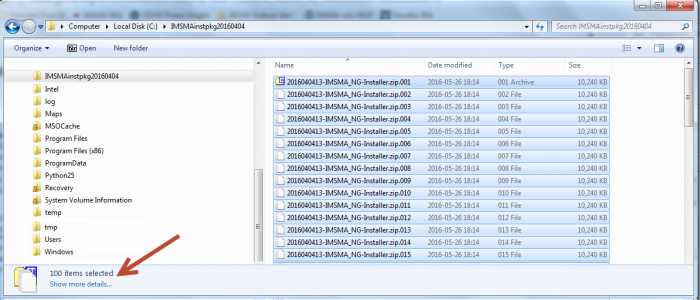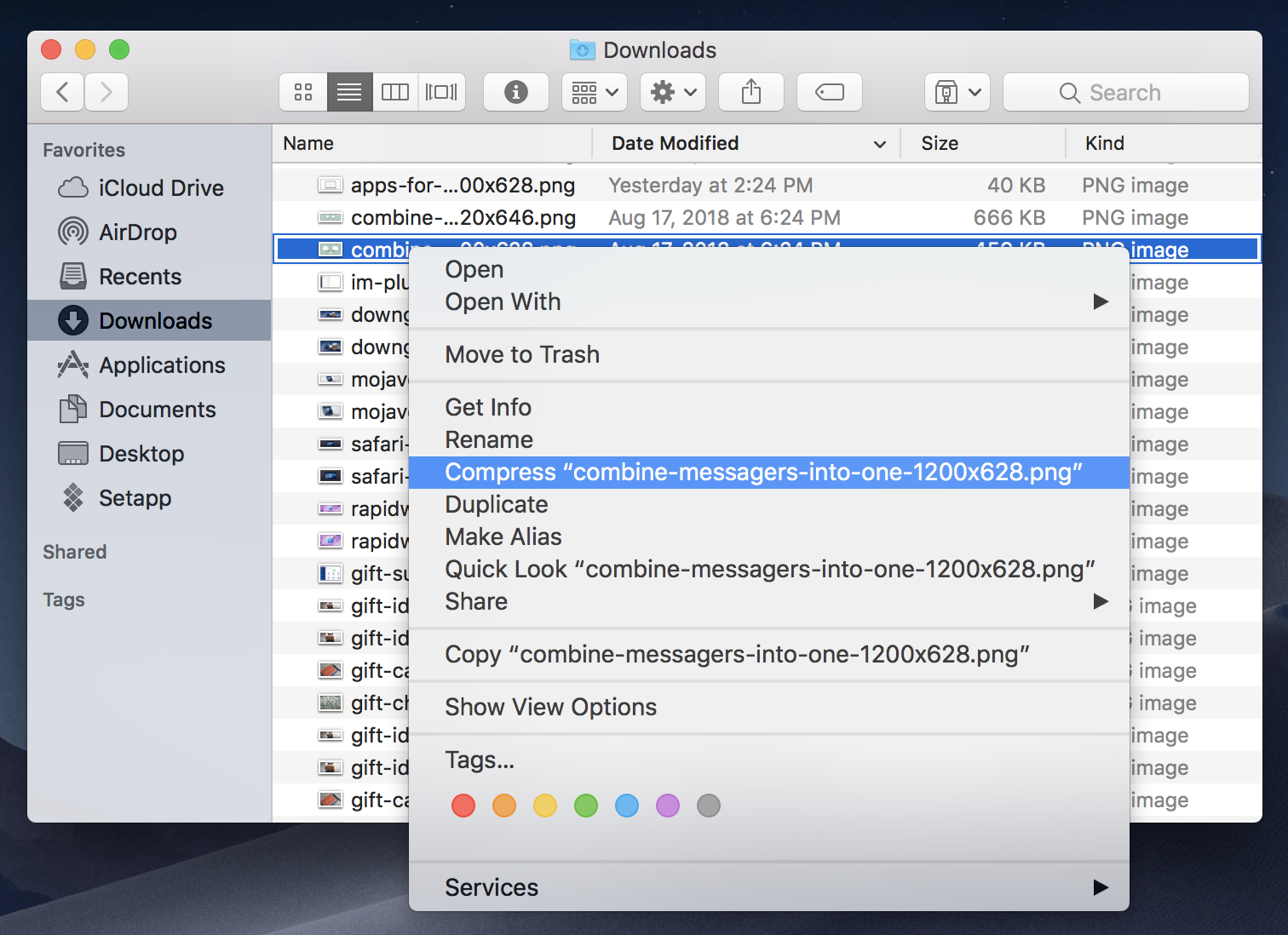The problem of Microsoft Excel opening Multiple Files on Mac or trying to recover AutoSaved files has been reported by many users. You will find below two easy methods to fix this issue on Mac.
Zip and unzip files and folders on Mac. Compress a file or folder: Control-click it or tap it using two fingers, then choose Compress from the shortcut menu. Unzip (expand) a compressed item: Double-click the.zip file. On your Mac, do any of the following: Compress a file or folder: Control-click it or tap it using two fingers, then choose Compress from the shortcut menu. If you compress a single item, the compressed file has the name of the original item with the.zip extension. If you compress multiple items at once, the compressed file is called Archive.zip. Then type the file name and click Create. Unzip RAR files on your Mac from the Context menu. With WinZip for Mac 2.0 or later, you can right-click (or press CTRL and click) your saved RAR files and use the Context Menu to unzip them. Click on Services at the bottom of the Context menu, then choose Unzip. Turning a conventional file (whether picture, video, music file, document or other type) or folder into a compressed zip file is very easy on a Mac: Right-click (or Ctrl-click) the file or folder. This is a relatively simple method of decompression. It only needs to move the zipped files to another location and unzip files Windows 10. Double-click the zipped folder and select the file you want to extract. You can select multiple or one file at the same time. Right-click on the selected file and select 'Cut' from the drop.

When Excel Starts, It Opens Multiple Files on Mac
When Microsoft Excel starts misbehaving on Mac, you may find it automatically opening several files or trying to recover AutoSaved files and then prompting you to open the last saved version.
When Excel prompts you to open the last saved version, it usually generates an error message reading “Excel saved changes to the file before the application quit unexpectedly”.
These problems have frustrated many Excel users on Mac, prompting them to seek for a solution from experts and others users on Microsoft support Forums.
There’s no warning, no errors just 8 workbooks opening every time I open Excel…. very frustrating to say the least. – SHAMrock4622 on answers.microsoft.com
You will find below two different methods to fix the problem of Excel opening multiple files on Mac. It is recommended that you try the first method, before moving to the second one.
While the second method offers a definite cure to the problem, it disables your Microsoft Excel login credentials on Mac and requires you to login back to Microsoft Excel.
1. Clear Startup Files in Excel Preferences
The problem of Excel automatically opening several files upon startup can be fixed by clearing the path to the Startup Files in Excel General Preferences.
1. Open Microsoft Excel on your Mac and wait as it stutters and tries to open or recover files.
2. Click on the Excel tab in top menu bar and select Preferences in the drop-down menu.
3. On Excel Preferences screen, click on the General icon.
4. On the next screen, click on the Clear button next to “At startup, open all files in:” entry.
If you do not want to land every time on Excel Workbook Gallery menu, uncheck Open Workbook Gallery when opening Excel option.
2. Rename UBF8T346G9.office Folder
This method fixes the problem by disabling all the current Microsoft Excel settings, which might be causing those weird Microsoft Excel Startup issues on your Mac.
As mentioned above, you will be required to login back into Microsoft Excel. Hence, make sure that you know the Email Address and Password to login to your Microsoft Excel Account.
1. Close all open Files and Quit Microsoft Office program on your Mac.
2. Click on the Finder Icon in taskbar > select the Go tab in top-menu bar and click on Go to Folder.
3. Type ~/Library/Group Containers/ in the search bar and click on Go button.
4. In Group Containers Folder, rename UBF8T346G9.office folder to UBF8T346G9.oldoffice.
5. Open Microsoft Office and login to your Microsoft Account.
Now, you will no longer find Microsoft Excel automatically opening multiple files or prompting you to open the last saved version of the file.

Note: Once you are logged-in, you can logout of Microsoft Excel and remain logged out.
Jul 08, 2021
3min Read
Sometimes when you want to download a file, you might notice that it comes in a .zip format. If you don’t know what it is and are having trouble opening it, you’ve come to the right place! This article is going to teach you how to unzip files using default applications in Windows and macOS as well as third-party programs.
Two Ways to Unzip Files
There are two ways to extract zipped files:
- By using your operating system’s built-in software.
- By using third-party tools.

Let’s look at each one of these options in more detail.
1. Using an OS Built-In Tool
First, let’s take a look at how to extract files using native software found in Windows and macOS. Because you’re only using what your computer already has, there is no need to download another tool.
Windows

While it is possible to see the content of a zip file by double-clicking on it on Windows, you still need to extract the files to use it. The Windows default support for .zip goes by the name of Compressed (zipped) folders and here’s how to use it:
- Right-click the file that you want to decompress and choose Extract All.
- Choose the directory where you want to keep the extracted files and click Extract. It is optional to check the box underneath if you need to see the content immediately after the extraction is done.
- The files that were inside the .zip now can be found in the location you picked in step two.
macOS

Archive Utility is Mac’s built-in tool that handles the .zip format. To unzip a file, follow these steps:
- Double-click on the file you want to unzip.
- Once extracted, the file will appear in the same folder as its archive.
Unzip Multiple Files Centos
If you want to change the default folder location, access Internal Hard Drive -> System -> Library -> Core Services -> Archive Utility. Once there, select Preferences and set the location by clicking Save Expanded Files.
If you’re using Linux, read here for an in-depth guide on how to unzip your file.
2. Using a Third-Party Tool
While it is not necessary to download third-party tools to extract a .zip file, they do come with added features that allow you to customize, password-protect, and repair your zip files.
Below are our recommendations.
7-Zip
This file archiver is a free and open-source program with a 2-10% higher compression rate compared to WinZip and PKZip. It also has its own 7z extension that compresses data 30-70% better than the .zip format.
Although it is only available for Windows, it also has a port for Linux/Posix command line called p7zip.
To unzip with this tool, follow these steps:
Unzip File Mac Terminal
- Right-click on the file that you plan to extract. 7-Zip should be listed there after installation.
- Hover your mouse above the program name, and you will see a drop-down menu with multiple commands. Click Extract Files.
- In the next menu, choose the save location by clicking on the three dots, leave it be if you want it in the same folder as the original. Click OK.
- Alternatively, you can also choose Extract Here to immediately save your file in the archive’s location or Extract to [File Name] to make a folder out of the extracted data.
Zipware
Just like 7-Zip, Zipware is also a Windows-only extractor. However, it has a few features that stand out, such as a streamlined file manager, a password manager, conversion of all compatible formats to .zip, .exe, or .7z and a virus scan.
Again, decompressing using this tool follows the same method as the previous ones with slightly different options:
- Extract to this folder – for immediate extraction to the location of the zip.
- Extract to this folder + Filenames – for a similar effect but with a folder made out of the file.
- Extract to other… – opens a drop-down menu to choose another location.
Regardless of what tool you use, it is a good practice to delete the .zip file after you extract its content because keeping both consumes more space.
Free Unzip For Mac
What is a .zip File?
A .zip file is an archive containing one or more files that have been compressed to reduce its size. Zipping a file is useful to spare up to 80% or more storage space.
Additionally, zipping big files enables users to upload and send them faster over the internet, simultaneously decreasing the chance of it being corrupted. Users can also use .zip format to encrypt their data for extra security.
There is plenty of software that can be used to unzip files. However, your computer is generally already equipped with a built-in program that can perform the task just fine.
Conclusion
A zip file is an archiving method that is useful to save storage since it compresses file sizes.
You can unzip files either using default Windows and macOS settings or by utilizing third-party software such as Zipware, and 7-Zip.
The process itself takes only a few clicks, so you can have the task done in no time.
Unzip Multiple Files Mac Free
Edvinas is a professional mentor and trainer of customer support agents. When he's not teaching new guys the secrets of providing an exceptional service, he likes to travel the world and play basketball.